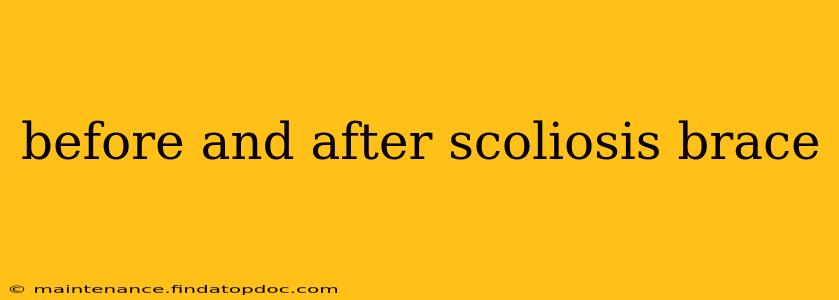Scoliosis, a sideways curvature of the spine, can significantly impact a person's posture, appearance, and overall health. For many individuals, bracing is a crucial non-surgical treatment option. This comprehensive guide explores the changes you can expect before, during, and after using a scoliosis brace, addressing common questions and concerns.
What Does My Body Look Like Before a Scoliosis Brace?
Before bracing, the visible signs of scoliosis vary depending on the severity of the curve. Mild scoliosis might only be detectable through a physical examination by a doctor, while more severe cases can result in a noticeable asymmetry of the shoulders, hips, or rib cage. One shoulder blade might appear more prominent than the other, and the waistline might appear uneven. The degree of curvature is measured using the Cobb angle, determined through X-rays.
What Happens When I First Start Wearing a Scoliosis Brace?
Adjusting to a scoliosis brace takes time and patience. Initially, you might experience discomfort, including:
- Pressure points: The brace can put pressure on certain areas of your skin, leading to redness or minor irritation. Proper fitting and padding are crucial to minimize this.
- Skin irritation: Friction from the brace can cause chafing or rashes. Regular skin checks and the use of breathable materials beneath the brace are essential.
- Limited movement: The brace restricts some movements, which may feel initially uncomfortable or awkward.
- Body image concerns: Adjusting to the appearance of the brace can be emotionally challenging for some individuals.
It's important to communicate any discomfort or concerns to your doctor or orthotists. They can make adjustments to the brace or offer solutions to address these issues.
What are the Benefits of Wearing a Scoliosis Brace?
The primary goal of a scoliosis brace is to prevent the curve from progressing further. By applying gentle pressure, it helps to slow down or stop the progression of the spinal curvature. This can significantly reduce the need for surgery in the future. Beyond that, bracing offers:
- Improved posture: Over time, the brace helps improve posture by gently correcting the spinal alignment.
- Reduced pain: While not a pain management solution on its own, the brace can help alleviate pain associated with scoliosis by supporting the spine and reducing strain.
- Improved self-esteem: As the brace helps correct the spinal curvature, it can positively impact a person's self-image and confidence.
What Can I Expect After Removing My Scoliosis Brace?
Once the brace is removed (the duration depends on individual needs and the severity of the scoliosis), several factors influence the long-term outcome:
- Continued spinal health: Regular follow-up appointments with your doctor are crucial to monitor the curve's stability after brace removal.
- Postural awareness: Consciously maintaining good posture remains important even after brace removal to prevent the curve from returning.
- Physical therapy: Physical therapy can help strengthen core muscles and improve overall spinal health.
- Potential for curve progression: While bracing significantly reduces progression, there's a small chance the curve might slightly progress or change after brace removal. Ongoing monitoring is vital.
The "after" picture is not always a perfectly straight spine. The goal is to prevent further progression and maintain a functional and healthy spine. Many individuals achieve excellent results, with minimal curvature changes after bracing.
How Long Do I Need to Wear a Scoliosis Brace?
The duration of brace wear varies depending on several factors, including:
- Age: Younger individuals often require longer treatment periods because their bones are still growing.
- Severity of the curve: Larger curves typically require longer bracing periods.
- Type of brace: Different brace types have varying treatment schedules.
- Individual response to treatment: Each individual responds differently to bracing.
Your doctor will determine the appropriate treatment duration based on your specific situation.
Does a Scoliosis Brace Affect My Growth?
While there's a misconception that scoliosis braces stunt growth, this is not entirely accurate. Modern braces are designed to minimize growth disruption. They can slightly affect growth in some cases, but it's often less significant than the potential impact of an untreated, progressing scoliosis curve.
What are the Different Types of Scoliosis Braces?
Several types of scoliosis braces exist, each designed to address specific curvature patterns and individual needs. Your doctor will recommend the most appropriate brace for your condition. Common types include the Boston brace, Milwaukee brace, and Charleston bending brace. The choice depends on factors such as the curve's location, severity, and the patient’s age and body type.
This comprehensive guide provides a general overview. Individual experiences with scoliosis bracing can vary significantly. It is crucial to consult with a medical professional for personalized advice and treatment.
